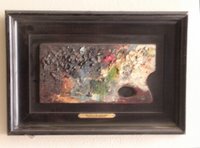Jurying the Annual Exhibition of American Painting and Sculpture
Concerning the Palette and Chisel,
Art historian, Wendy Greenhouse,
has noted that
"beginning in 1917 it counted members on the jury of the prestigious
American annual exhibition at the Art Institute"
The catalogs for those exhibits are now online ,
and the following P&C members served on those juries
for the following years:
Art historian, Wendy Greenhouse,
has noted that
"beginning in 1917 it counted members on the jury of the prestigious
American annual exhibition at the Art Institute"
The catalogs for those exhibits are now online ,
and the following P&C members served on those juries
for the following years:
1917: Harry Engle
1918: Albin Polasek, Emory Seidel, Adam Albright, J. Jeffrey Grant
1919: Arvid Nyholm, Rudolph Ingerle
1920: Grant,Alfred Juergens, Carl Krafft, Lawrence Mazzanovich
1921: Polasek , Seidel
1922: Krafft, Polasek
1923: J. Jeffrey Grant
1924: Wilson Irvine, Oskar Gross, Polasek
1925: Eugene Savage, Arthur Rider
1926: Krafft
1927: Ingerle, Seidel
And that was it for the Palette and Chisel.
In 1930, the museum began to assemble separate juries in Chicago and New York.
The Chicago juries comprising one or two Chicago artists, plus distinguished artists from around the country, as well as museum trustees.
In 1933, the jury began to include directors of other, Midwestern museums.
In 1939, the museum held a 50-year retrospective called "A Half-Century of American art" -- with museum staff selecting items that had previously been in the Annual exhibits. The catalog included a long essay by Director, Daniel Catton Rich, which concluded with the prophetic words:
"When Chicago stages its "Century of American Art" in 1988, what a different story it will tell".
In 1940- Chicago and New York juries for painting were combined -- and it was two east coast painters.
After 1942: There were no more juries -- and museum professional staff did all the selecting.
In the 1960's, the show became biennial -- and moving into the 1980's, it began to skip 4 years at a time.
In 1986, James wood, the recently retired director of the A.I.C., wrote the introduction to the catalog.
He made mention of poor Ms. Logan, who had donated an award in her name, only to live to see it given to art she couldn't stand. (she wrote the famous diatribe: "Sanity in Art")
Wood concluded his introduction with these words:
"As the century ends, the American exhibition
remains as vital and contributive as ever"
remains as vital and contributive as ever"
And the American exhibit was never held again.





























